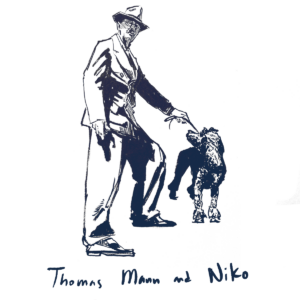
Thomas Mann and family on Will Rogers State Beach.
Photo courtesy: ETH-Bibliothek Zurich. Photographer Fritz Krauskopf.
By LIBBY MOTIKA
Circling the News Contributor
When the homeland becomes foreign, the foreign becomes the homeland.
This sentence was the blueprint for so many of the German anti-fascists who fled Hitler’s savage despotism to find refuge in the United States. These were the writers, filmmakers, musicians and philosophers who came to the U.S. without much of a plan except to try and establish a new life in a place that was so out of context with what they had known.
In the new book “Thomas Mann’s Los Angeles: Stories from Exile 1940-1952” (Angel City Press), editors Nikolai Blaumer and Benno Herz focus on the famous German writer and anti-fascist and the life he made in his adopted home.
Blaumer, the former program director of the Thomas Mann House in Pacific Palisades, and Herz, the current project manager, have created a chronicle of Mann’s time in LA: his daily routine, his family life, his coterie of fellow exiles, and the many places in L.A. he frequented.
Inspired by stories related to them about the exiles on the Pacific Coast, the authors conceived the project. They enriched the book with essays by a number of scholars and authors who have researched the German exiles in California and the Mann family.
Introducing the book at a recent event at the Mann house on San Remo Drive, Blaumer and Herz brought together three of the book’s contributors, who offered insights and context for Mann’s 10-year exile.
Panelists included Tobias Boes, whose most recent book traces how Mann became one of America’s most prominent anti-Fascists.
Donna Rifkind’s book details the life of screenwriter Salka Viertel and Hitler’s exiles in the Golden Age of Hollywood.
New Yorker staff writer Alex Ross has written often about Mann and the émigré community of Los Angeles.
By the time Mann arrived in the United States as a Nobel Laureate, he was one of the most celebrated writers, but also a fiercely outspoken anti-fascist, who left little doubt about the need to crush Hitler.
His prominent opposition to the Nazi regime was countered by the imminent threat of expulsion or incarceration. While he spent his initial post-Germany years in Europe, his first visit to the United States, in 1936, planted the idea for his eventual emigration.
After a foray lecturing at Princeton, Mann and his wife Katia and six children moved to Los Angeles in 1940, renting a house in Brentwood. Not long after, he decided to make California their home and acquired land on San Remo, not far from friends and acquaintances Aldus Huxley and Bruno Frank, and the philosopher Ludwig Marcuse.
Fifteen-Fifty San Remo provided not only a home for the family, but also a hospitable gathering place for Mann and the many German writers, musicians and filmmakers who enjoyed intellectual and emotional familiarity.
For Mann, San Remo also provided a quiet remove from a hectic schedule of public lecturing, and to get away from “meddling sponsors.” Now he could enjoy a return to fiction. It was in the San Remo years that he wrote “Dr. Faustus.”
“Thomas Mann’s Los Angeles” encompasses the author’s whole world not only with essays on the intellectuals and artists but also the quotidian details of his life.
Literary critic and author Morton Hoi Jensen writes about Mann’s association with Eleanor Roosevelt, whom he met in 1935. The two had assisted, behind-the-scenes, in the safe emigration of German and Jewish intellectuals, and had helped to establish the Emergency Rescue Committee, which is credited with saving between 2,000 and 4,000 Jewish refugees.

Illustration: Jon Stich
Other chapters give the reader a sort of diary of Mann’s lifestyle and routines. Herz comments on the family’s day trips to Will Rogers Beach, walks in the neighborhood with his poodle Niko, and visits to the Hollywood Bowl. The LA Philharmonic conductor Bruno Walter, one of Mann’s closest friends, invited him to many concerts and exclusive rehearsals.
His favorite restaurants included the Brown Derby and the Hotel Miramar. Mann also enjoyed the movies, although he purposely chose to live far away from Hollywood, the studios and the glamorous film premieres. He questioned the genre in general, as antithetical to the “high arts,” the theater and literature.
Mann was indeed a complicated man, at once upholding his German sensibility in art and décor while fiercely engaging in the political and humanitarian initiatives living in America afforded. The interior of his house on San Remo (replicating his home in Munich) was in contrast to its modernist exterior. “On the outside, adaptation to the California modern; on the inside, memories of the homeland,” the authors write.
In the end, however, Mann’s activities looked more and more precarious. America was gripped by a hyper apprehension of the spread of Communism, and the government rounded up supposed Communist sympathizers and expelled a number of German émigrés.
When the House Un-American Activities Committee listed Mann as affiliated with various peace organizations or Communist fronts, the Mann family decided to move to the safe haven in Switzerland in 1952, ending their 12-year idyll in California.
Despite his departure, he did not want to give the impression that he was turning his back on or condemning America, which had become his home, and to which he owned so much. He added in a letter to his friend journalist, philanthropist and civil rights activist Agnes Meyer: “Please help, if there should be a need, to counter that impression! I’m remaining, of course, an American Citizen.”
The Thomas Mann house is not open to the public, although it hosts a series of events throughout the year that are open to the public. Visit: vatmh.org.

The Thomas Mann house is located in the Palisades Riviera.
Photo by Mike Kelley

Are there programs at Thomas Mann’s house that the public is invited to?